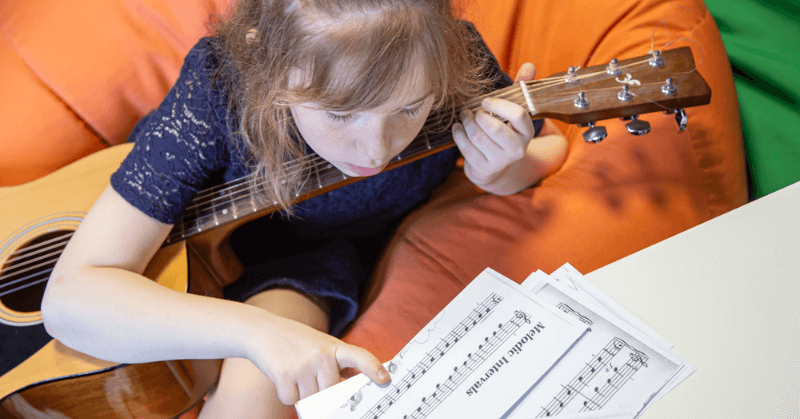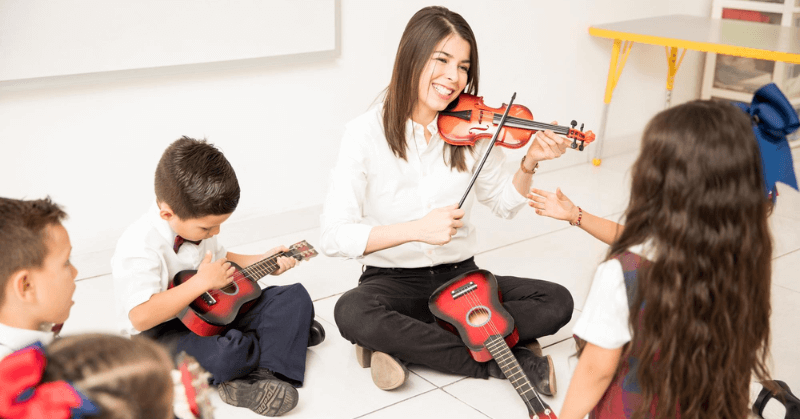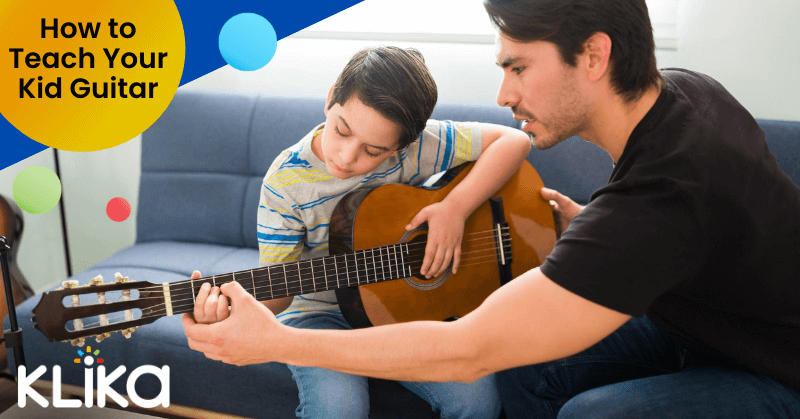Guitar playing is a skill that can be learned at any age, and teaching your child to play guitar can be both an enjoyable and rewarding experience. With the right instruction and practice, your child can soon become a proficient guitar player. In this blog, we'll discuss the basics of teaching guitar to kids. So, whether you're looking to provide your child with a new hobby or simply introduce them to the joys of playing music, read and use this guide that’ll help you and your child get the most out of this journey!
1. Start with the basics

As a parent, it’s important to introduce your child to the basics of guitar playing before they dive into the more complicated chords and songs. This can be a fun and engaging activity for both you and your child, as they get to explore the world of music and discover their creative potential. Teaching them the basics can also set them up for success as they progress in their guitar playing.
Show them the parts of the guitar
The first step in teaching your child to play the guitar is to introduce them to the parts of the instrument. Show them the neck and bridge, and explain what they do. Let them explore the strings and point out the tuning pegs. Show them how to hold the guitar and how to position their left and right hands correctly.
Teach them the names of the strings
Another important step is teaching them the names of the strings, as well as how to press down on them for the right notes. Start with the thinnest string first and gradually move up the strings. Show them how to press down on the string to produce the correct pitch, and how to find the correct fret for each note.
Start with the basic chords
Once your child has a good understanding of the parts of the guitar and how to press down on the strings, they’re ready to start playing some basic chords. Start with the three-finger G chord and then move on to the C and F chords. As they progress, you can introduce them to the more complicated chords and songs.
Teaching your child the basics of guitar playing is the foundation to unlocking their potential in music. With the right guidance and support, they’ll be on their way to becoming a guitar virtuoso in no time!
Watch this short video on playing the G and C chords!
2. Make it fun

Learning a new instrument can be difficult, but it doesn’t have to be a chore. Making the experience fun and enjoyable will help your child stay motivated and engaged in the process.
There are a few things you can do to help make learning a new instrument an enjoyable experience for your child.
Don’t pressure them
Ensure that you are not pressuring them too much. It is important to give them time to explore the instrument and make mistakes without feeling overwhelmed.
Use songs that your child knows
Playing familiar tunes will help your child recognise the notes they are playing and remember the song. This will keep them from getting frustrated or disinterested in the process. You can also make up your own songs and melodies to help keep things light and interesting.
Incorporate fun activities into the practice sessions
Have your child play along to pre-recorded music or sing along to their favourite songs. Let them create their own tunes and rhythms. This will help them become more engaged and excited about the process.
Reward your child for their hard work and progress
Acknowledge their achievements and show them how proud you are of them. This will help motivate them to continue learning and playing the instrument.
Learning a new instrument can be difficult, but with some patience and encouragement, it can be an enjoyable and rewarding experience. By keeping things light and interesting and providing rewards for progress, your child will be more likely to stay motivated and engaged in the process.
3. Practise, practise, practise

No matter what instrument your child is learning, regular practice is essential for mastering the instrument. It takes time, effort, and dedication to gain proficiency in any instrument, and this starts with regular practice. To ensure your child has the best chance at developing their skills, set aside a specific time each day for them to practise, and make sure to be around for guidance and encouragement.
Set aside regular practice time
By setting aside regular practice time, your child will begin to develop the discipline necessary to become a successful musician. As they progress in their learning, they will understand the importance of making a commitment to regular practice, enabling them to focus their efforts on developing their skills.
Guide them
It is also important to provide your child with helpful guidance while they are practising. This can range from taking notes on the music they are playing, to teaching them the proper techniques for playing the instrument. When your child is stuck on something, encourage them to take a break and step away from the instrument to give their brain some time to process the information.
Encourage them
Finally, it is important to provide your child with encouragement during their practice sessions. Be mindful of how your words and actions can shape their outlook, and be sure to celebrate even the smallest successes. This will help to keep them motivated and will provide them with the confidence they need to keep going.
Overall, regular practice is essential for mastering any instrument. By setting aside specific practice time each day, providing helpful guidance and encouragement, and celebrating even the smallest successes, you will help your child to develop the discipline and confidence they need to become a successful musician.
4. Incorporate music theory

Learning theory is essential to understanding music and can help your child to become a more well-rounded musician. Take time to explain music notation and the fundamentals of music theory, such as rhythms, scales, and intervals.
Rhythms
Rhythms are a fundamental element of music. Learning about rhythm helps your child understand the structure and timing of music. It is important to explain to your child the concept of beats and the different types of rhythms. Help your child understand the concept of metre and the different types of metres, such as duple, triple, and quadruple.
Scales
Scales are another essential element of music. Scales help your child understand the relationship between notes. Explain to your child the concept of a major scale, as well as how different scales are used in different genres of music.
Intervals
Intervals are a key part of understanding music. Intervals are the distances between two notes. Explain to your child the concept of intervals and how they are used to create melodies and harmonies.
Let them watch this fun video to know more about music theory!
5. Introduce your child to other instruments
Playing the guitar is just one part of making music. While it’s a great instrument to learn, it’s important to expose children to other instruments as well. This helps them gain a better understanding of different sounds and how they combine to create a beautiful piece of music.
Introducing your child to other instruments can help to open up their creativity and give them a greater appreciation for music. It can also help them to better understand how different elements work together to create a song.
Let them explore
When introducing your child to different instruments, start with the basics. Allow them to explore each instrument and experiment with different sounds. This is an important part of learning and will help them to develop a better understanding of how music works.
Start with the most commonly taught instruments

You may want to begin with the most commonly taught instruments such as the piano, violin, and guitar. As your child becomes more comfortable with these instruments, introduce them to some more unusual instruments. Things like the ukulele, harp, or even a kazoo can be a great way for them to explore different sounds.
Attend concerts or visit a music store
Another great way to introduce different instruments is to attend a concert or visit a music store. This way, your child can get a firsthand look at the different instruments and how they work together to create a piece of music.
Take your child to music classes
This can be a great way to introduce them to more complex instruments and teach them about how music works. It can also give them a chance to collaborate with other children and learn how to work together to create a beautiful piece of music.
No matter how your child is exposed to different instruments, it’s important to remember that music is fun! Encourage your child to explore and find joy in the sounds they create, and you may be surprised by the beautiful music they come up with.
Ready to get started? Browse through Klika’s wide range of children's guitars and follow these tips to get your child started on their musical journey!










